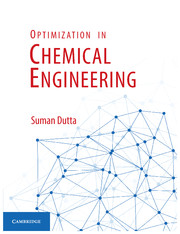Book contents
- Frontmatter
- Dedication
- Contents
- List of Figures
- List of Tables
- Preface
- 1 A Brief Discussion on Optimization
- 2 Formulation of Optimization Problems in Chemical and Biochemical Engineering
- 3 Single Variable Unconstrained Optimization Methods
- 4 Trust-Region Methods
- 5 Optimization of Unconstrained Multivariable Functions
- 6 Multivariable Optimization with Constraints
- 7 Optimization of Staged and Discrete Processes
- 8 Some Advanced Topics on Optimization
- 9 Nontraditional Optimization
- 10 Optimization of Various Chemical and Biochemical Processes
- 11 Statistical Optimization
- 12 Software Tools for Optimization Processes
- Multiple Choice Questions – 1
- Multiple Choice Questions – 2
- Multiple Choice Questions – 3
- Index
- References
2 - Formulation of Optimization Problems in Chemical and Biochemical Engineering
Published online by Cambridge University Press: 05 February 2016
- Frontmatter
- Dedication
- Contents
- List of Figures
- List of Tables
- Preface
- 1 A Brief Discussion on Optimization
- 2 Formulation of Optimization Problems in Chemical and Biochemical Engineering
- 3 Single Variable Unconstrained Optimization Methods
- 4 Trust-Region Methods
- 5 Optimization of Unconstrained Multivariable Functions
- 6 Multivariable Optimization with Constraints
- 7 Optimization of Staged and Discrete Processes
- 8 Some Advanced Topics on Optimization
- 9 Nontraditional Optimization
- 10 Optimization of Various Chemical and Biochemical Processes
- 11 Statistical Optimization
- 12 Software Tools for Optimization Processes
- Multiple Choice Questions – 1
- Multiple Choice Questions – 2
- Multiple Choice Questions – 3
- Index
- References
Summary
Introduction
The major application of optimization in the chemical engineering field is minimizing energy consumption in process plant. Other applications include the optimum design of fluid flow systems, optimization of the separation process, and optimization of product concentration and reaction time in reacting systems. Estimation of the overall cost for any plant design is also a vital part. Optimization of process variables is the tool for the same. In biochemical engineering, optimization is required for finding the optimum operating conditions of a bioreactor, and parameter estimation in biochemical pathways. The process of optimization requires proper formulation of the objective function and necessary constraint functions. The objective function can be formulated in different ways based on the number of variables involve in the process. If the process mechanisms are known to us and the number of variables are less, then objective functions are formulated based on basic principles of science and technology (e.g., law of conservation, thermodynamic laws). Moreover, if the process mechanisms are complicated and not known to us, number of variables are large; statistical optimization methods like Response Surface Methodology (RSM) and Artificial Neural Network (ANN) are applicable for those processes.
Formulation of Optimization Problem
One of the important steps during the application of optimization technique to a practical problem is the formulation of objective functions. We have to develop the model equations based on the physical appearance of the system. When we are formulating the mathematical statement of the objective, we have to keep in mind that the complexity increases with the nonlinearity of the function. During optimization, more complex functions or more nonlinear functions are harder to solve. There are many modern optimization software (see chapter 12) that have been developed to solve highly nonlinear functions. Most of the optimization problems comprise one objective function. Even though some problems that involve multiple objective functions cannot be transformed into a single function with similar units (e.g., maximizing profit while simultaneously minimizing risk).
Fluid Flow System
Liquid storage and transportation trough pipeline is very common in chemical process industry. In this section, we will discuss about the design of optimization storage tank and optimum pump configuration.
Optimization of liquid storage tank
A cylindrical tank (Fig. 2.1) has a volume (V) that can be expressed by V = (π/4)D2L, and we are interested to calculate the diameter (D) and height (H) that minimize the cost of the tank.
- Type
- Chapter
- Information
- Optimization in Chemical Engineering , pp. 12 - 39Publisher: Cambridge University PressPrint publication year: 2016

